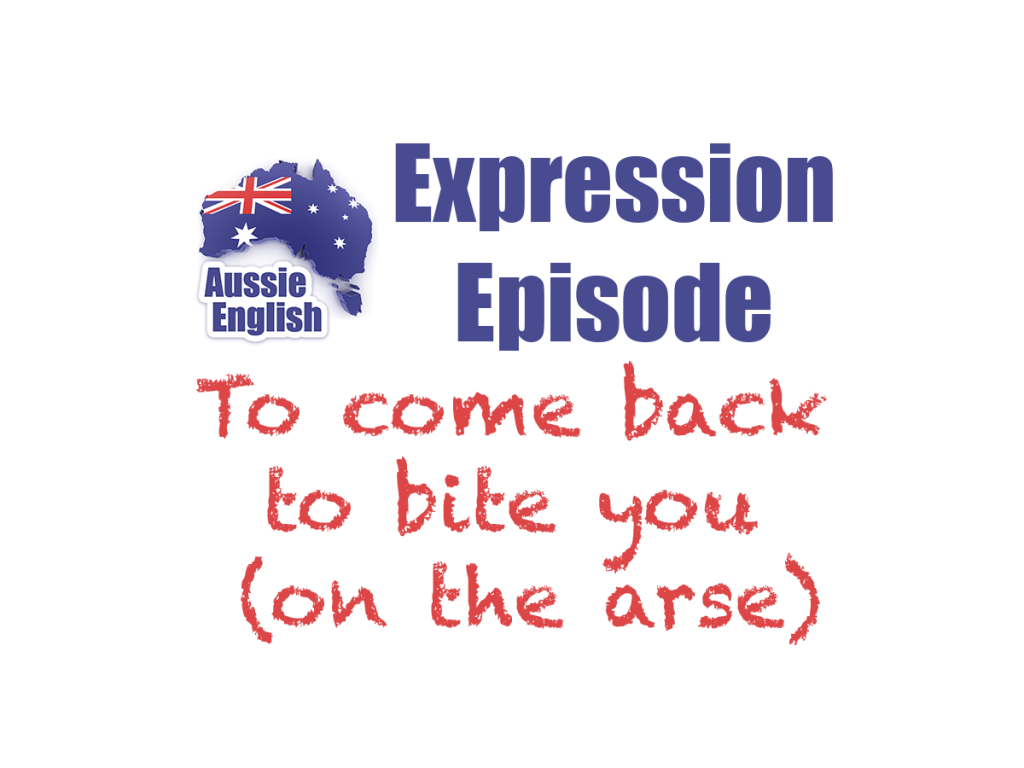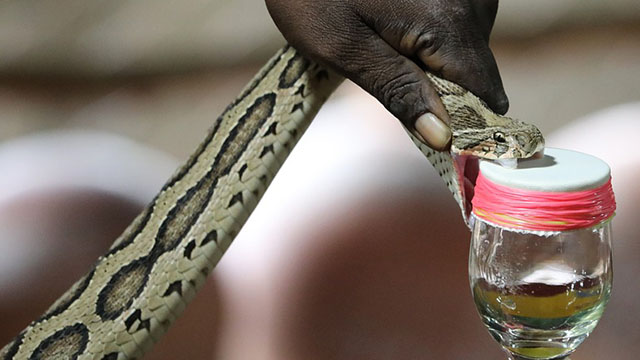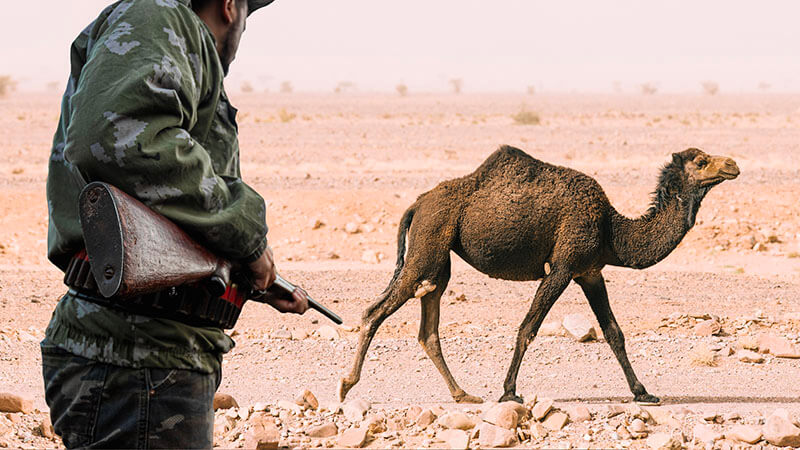AE 483 – Expression: Bite the Bullet
Learn Australian English in this expression episode of the Aussie English Podcast where I teach you to use to BITE THE BULLET like a native speaker.
AE 483 – Expression: Bite the Bullet
So, you ran home and you told your mum you saw some big dog-like…
I saw a dog. I said I… We saw a dog, a big dog, in the bushes eating something.
Yeah.
And she said, “Well, it can’t… you couldn’t have, because there’s no dogs here. And I said, but we did. We saw this big dog and it had stripes on it and it was eating something. And we ran home and she said, “Well, you couldn’t really, because there’s no dogs here.” And so, she said to my father, you know, “The kids think they’ve seen a dog and they’re saying it had stripes on it.”. You know? And he reckoned, it… “Well, all I can think of is they must’ve seen a tiger.”.
****
G’day, you mob! Welcome to this episode of the Aussie English Podcast, the number one podcast for anyone and everyone wanting to learn Australian English or just English in general.
It’s great to have you here today, guys. I hope you’re having a ripper of a weekend.
So, that intro scene. That was a video from a YouTube channel called ThylacineResearch. The link in the transcript if you’d like to check out the entire video. But it was a snippet, it was a little clip from that video, and we’ll be talking about thylacines, an extinct Australian predator, but which often gets sightings reported by people even today, although, these sightings always inevitably end up unsubstantiated, in that they can’t prove they actually saw the animal. Anyway, guys.
This is the Aussie English Podcast. It’s brought to you by the Aussie English Classroom. This is where you will get all the bonus content for the expression episodes. Every single expression episode, like this one at the moment, comes with three videos as well that go through pronunciation, vocab, and different expressions, that I use. So, that’s there to really give you a boost if you’re trying to advance your English quickly, and it also has a listen and read section where you can go through the entire transcript whilst you listen, you can read, and you can learn all the more complicated vocab in these episodes like the word ‘unsubstantiated’ for example. Anyway.
The Aussie English Classroom, guys. Sign up there. It’s a dollar for your first 30 days, an amazing deal, you can try it for an entire month for one dollar. That’s a couple of cents a day. And you can cancel at any time if it’s not for you. But if it is for you, I promise you you’re going to level up your English fast.
Aside from that, guys, if you would like the transcripts and the MP3s for today, don’t forget to sign up at TheAussieEnglishPodcast.com, and that is only five dollars a month, the cost of one coffee in Melbourne. So, if you were to buy one coffee a month, that covers the transcript and MP3 subscription at TheAussieEnglishPodcast.com.
Anyway, I hate doing those announcements, but that’s how I make money, guys, that’s how I keep the lights on, that’s how I keep doing what I’m doing, and that’s how you guys can support Aussie English whilst also improving your English. So, big thanks if you’re already signed up. Anyway.
Before we get into the expression today, let’s get in to the Aussie English joke. And it’s another good one, it’s another good one, because it’s kind of a play on words, it’s a pun, as usual. I think these jokes are really ‘punny’. So, here’s the joke.
Did you hear about the kidnapping at school? Did you hear about the kidnapping at school? It’s fine. He woke up. It’s fine. He woke up.
Do you get it? Okay, so the joke here is on the word ‘kidnapping’ and this, in this joke, is a single word, which is where you capture a child or a person and you hold them against their will and you usually ask for a ransom, you ask for someone to pay some money, before you release this person, right? So, if someone kidnap me, they held me captive, they might send my parents or my loved ones a message and say, if you give us a thousand dollars, we’ll let Pete go. Hopefully, I’d get more money than a thousand dollars, though, I think I’m worth more than that.
But the joke here is that if you say ‘kid napping’, as in, a kid taking a nap, it is that the kid is sleeping, right? He’s having a quick sleep. So, did you hear about the kidnapping at school. It could be the kid being stolen and held captive or it could be the kid sleeping, and then the answer: It’s fine. He woke up. So, you were thinking he was stolen, but he was actually just sleeping. So, there you go, guys. That was the joke.
Today’s expression is ‘to bite the bullet’, ‘to bite the bullet’. I wonder if you guys have heard this expression before and know how to use it, ‘to bite the bullet’.
So, this one comes from Thomas who suggested this in the Aussie English Classroom a Facebook group. We all voted. It was neck and neck for a while. Aykhan and Lima and Thomas were all ahead of the crowd, they were all ahead of everyone else, all pretty even, but then Thomas came out ahead and won. Good job, Thomas. Alright.
So, let’s go through and define the words in the expression ‘to bite the bullet’. We’ll define the expression, talk about the origin, give some examples, go through a listen and repeat exercise, and then talk about the thylacine. Okay, so let’s get started with the definitions though.
To bite. Obviously, you guys will know what ‘to bite’ is. If you bite something, it’s that you close your jaws, your teeth around something, sink your teeth into something, and apply pressure. You know, if you put food in your mouth, you will bite the food. If you are a little kid and your sister or brother’s playing up and you get angry, you might bite them.
A bullet. ‘A bullet’ is the metal slug. The metal slug that’s usually made of a hard or heavy dense metal like led or tungsten that is fired from a gun. You know, a 9-millimeter pistol, an AK 47, any kind of gun like that fires a bullet. A bullet.
Now, let’s go through the ex… There’s a pick-up truck outside picking up the rubbish. Making all this noise. Anyway. Let’s go through the expression definition, guys.
So, if you bite the bullet, if you bite the bullet, it just means to decide to do something difficult or unpleasant that you’ve been putting off, that you’ve been hesitating over, or that you have been procrastinating about. So, to accept an inevitable impending hardship, something difficult to do, and then endure the resulting pain or hardship with fortitude. So, to do it and be strong whilst you do it, okay? To bite the bullet.
So, there were a few different theories about where this expression came from when I was researching this. And the first one was that, apparently, biting the bullet meant using a shell casing, the bottom part of a bullet that’s… before it is put in the gun, to cover a tooth in your mouth that’s aching so that instead of biting that broken tooth in your mouth where the nerve is exposed and it could really hurt, when you bite down, you’ll actually bite the shell casing, the bullet casing instead.
The other theory was that biting the bullet could have originally been ‘biting the billet’ or ‘the billet’, French word, ‘billet’, I believe, and ‘billet’ meant a piece of wood. And you’ve probably seen in those movies when someone’s getting surgery, you know, they’re getting a bullet removed or something after they’ve been shot or they’re having an arm or a leg amputated, you know, back in the day, back in the 1800 or something before anesthetic, they would put a piece of wood, ‘a billet’, in the person’s mouth so that when they bit down from the pain, they wouldn’t break their teeth. So, that was the other hypothetical theory of where this expression came from.
However, there is no evidence that those two theories are correct. However, the first recorded use of this expression was by Rudyard Kipling in his novel The Light That Failed from 1891 and the quote was:
“Steady, Dicky, steady!”, said the deep voice in his ear and the grip tightened. Bite on the bullet, old man, and don’t let them think you’re afraid!”.
All right, so let’s go through some examples of how I would actually use this expression though, ‘to bite the bullet’, ‘to bite the bullet’. Alright.
Number one. It is a day with horrible weather. It’s raining outside. Maybe there is hail or snow or sleet. It’s just horrible weather. Lightning, thunder. You don’t want to go outside, but you’ve got to do some chores. So, you’ve got to go outside. You’ve got to mow the lawn or you’ve got to take out the trash. So, you woke up in the morning and the weather was horrible, it was atrocious. You’ve hesitated for a few hours, you’ve procrastinated, you’ve held things off, you’ve avoided doing the task you’re meant to be doing in the hopes that the weather will clear up, that the sun would come out and it would be more enjoyable. Eventually, though, you stop beating around the bush, you stop procrastinating, you stop putting things off, and you bite the bullet and you go and do your chores. So, you accept the inevitable impending hardship and you endure the resulting pain with fortitude. You go out there and you’re like, you know what, it’s raining, but I do this. So, someone might tell you. Good job, you sucked it up, you were strong, you bit the bullet, and you got it over and done with. You went outside and did the chores.
Example number two. Imagine you’ve got a toothache and it’s killing you. Not literally, not literally. We say, if it’s killing you, it just means that it really, really hurts. My tooth is killing me. It’s hurting me so much. It’s killing me. So, you’ve got a toothache. You need to go see the dentist to have him check out your tooth, but you’re afraid of dentists, they freak you out, and you’re worried if you go, you’re going to have to get an injection or it’s going to really hurt. Maybe you have to get a tooth pulled. It’s going to be unpleasant. Eventually however, the pain becomes so much you snap, you crack, you have to bite the bullet, and you decide enough is enough, it’s too painful, I need to get my tooth sorted out. I need to get it dealt with. So, when you go see the dentist, he checks the tooth out and finds that, indeed, it does need to be pulled out, and he might say he is really glad that you bit the bullet and came to see him as it was just in the nick of time, because your tooth’s infected and it needs to be removed.
Example number three you’re a boss who runs a huge company and unfortunately the stock market hasn’t been kind to your company and you’ve lost a lot of money. As a result, you have to let a lot of employees go in order to save money and keep the business or the company afloat, to keep it going. So, you’ve got to let a few employees go, you have to fire them, you have to say, sorry, guys, we can’t keep you on anymore. We don’t have the money. So, you really don’t want to do this, but you know you have to do it, you have to accept this inevitable impending hardship, this unpleasantness, and you have to face up to it and deal with it with fortitude. So, you have to bite the bullet and do what needs to be done. So, you do, you do that, you bite the bullet, you have a meeting, you call everyone in, and you tell them, regretfully, unfortunately, they’re going to be made redundant.
So, that’s it, guys. I hope you understand the expression ‘to bite the bullet’. It means to accept the inevitable impending hardship that is facing you and then endure that resulting pain with fortitude.
So, let’s go through a little listen and repeat exercise, guys, now where we can practice our pronunciation. Listen and repeat after me and try and mimic, try and copy, try and imitate my accent. Let’s go.
To
To bite
To bite the
To bite the bullet x 5
Good job. Good job, guys. And now let’s practice contracting ‘going to’, okay? So, many go through and contract this sentence as ‘I’m going to’, ‘you’re going to’, ‘he’s going to’, but you may notice that when native speakers speak English in any country, when they speak really quickly, they’re not going to say, ‘I am going to’, they’re going to say ‘I’m gonna’. They’re not going to say, ‘you are going to’, they’re going to say ‘you’re gonna’, okay? So, listen and repeat after me, guys, and try and do this contraction of ‘going to’ into ‘gonna’,’gonna’. Okay? Let’s go.
I’m going to bite the bullet
You’re going to bite the bullet
He’s going to bite the bullet
She’s going to bite the bullet
We’re going to bite the bullet
They’re going to bite the bullet
It’s going to bite the bullet
Good job, guys. Remember, if you want a more in-depth and thorough breakdown of the pronunciation from today’s episode, that will be included in one of the three videos that will come out for this episode this weekend in the Aussie English Classroom. So, get in there. TheAussieEnglishClassroom.com, sign up and give it a go. You’re going to love it. All right.
So, now let’s do the Aussie English fact, guys, and we’ll finish up for the day.
So, today’s fact is about the thylacine and this is one of Australia’s coolest marsupials, at least in my opinion. Okay? The thylacine. So, I hope you guys know what the thylacine is. If you haven’t, if you haven’t heard about it, I recommend searching in Google, ‘thylacine’, and you will see a really cool animal. And thylacine is spelt T-H-Y-L-A-C-I-N-A. Okay? The thylacine.
So, the scientific name for the thylacine was Thylacinus cynocephalus also known as the Tasmanian Tiger or the Tasmanian Wolf, and it was the largest known carnivorous marsupial of modern times in Australia. It was known as the Tasmanian Tiger, because of the vertical black stripes that it had on its lower back.
Although, when Europeans arrived Down Under, in Australia, in the late 1700s, unfortunately, the thylacine was only native to Tasmania, that state that is the island in the bottom south east of Australia. It was once found across continental Australia, though, and as well, it was also found in New Guinea.
Surviving evidence suggests that the species was relatively shy and elusive and it was a nocturnal predator, meaning it was active at night time. And it was about the same size and build of a medium-to-large-size dog. So, maybe a small Labrador if you can imagine a small black Labrador. I have one of those, or at least my family have one of them. (I) love Labradors.
Despite its close resemblance to a dog, though, it was not a placental mammal like dogs and cats. Instead, it was actually a marsupial, which means it has a pouch and it is a lot more closely related to kangaroos and koalas and wallabies than it is to say dogs and cats and bears. As a result of being a marsupial, as I just said, it had an abdominal pouch, and this is where the females would keep their young whilst they were raising them from the vulnerable early months of their lives. And they’re actually one of the very few marsupials where the males have a pouch as well.
Like tigers and wolves from the northern hemisphere, the thylacine, in the Southern Hemisphere, in Australia, was an apex predator, and it’s a great example of convergent evolution where two unrelated species have evolved to occupy a similar niche. So, they have a similar ecological niche, that’s the biological term, and as a result they display the same general form and adaptation. So, when you see a thylacine and a dog put next to one another in a picture, they look similar even though they’re not related, and it’s because they eat the same things, they hunted the same way, they occupied the same niche in nature.
Its closest relative is thought to be the Tasmanian Devil, which we still have today, or the numbat.
The thylacine has been described as a formidable predator because of its ability to survive and hunt prey in extremely sparsely-populated areas.
It was the last extant member of its family, Thylacinadae, and became extinct only in the 20th century, in the early 1930s. Unfortunately, farmers at the time feared their livestock was threatened by the thylacine, that the thylacine was hunting their sheep or their cows or their goats. And thus, intensive hunting was encouraged by bounties from the government and this is generally blamed for the species extinction. However, other contributing factors may have been disease, the introduction of dogs, as well as human encroachment into their habitat.
Although, it is officially classified as extinct, sightings are still reported today, even though none of these have ever been conclusively proven, and that was that video at the start of today’s episode.
Despite the export of breeding pairs of thylacines, these were unsuccessful, and the last thylacine outside Australia died at London’s zoo in 1931. The good thing is you can still see videos of this beautiful animal alive roaming around, albeit, in a zoo cell, on YouTube. So, if you want to check it out, type in ‘thylacine’ into YouTube and you’ll get to see these.
Anyway, guys, I hope you enjoy today’s episode. I hope you learnt a whole bunch. I hope you got to improve your pronunciation. I hope you have a great weekend. I’m off to catch up with some mates, have a beer, have a burger, chill out. So, I’ll chat to you guys soon. See ya!
Here's what you get when you sign up!
- Read while you listen using the Premium Podcast player.
- Understand every word in every episode.
- Download all PDF transcripts and MP3s for 600+ episodes.
- Get access to bonus member-only episodes.












Responses